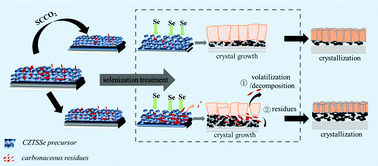Boosting the efficiency of solution-based CZTSSe solar cells by supercritical carbon dioxide treatment†
Abstract
Cu2ZnSn(S,Se)4 (CZTSSe) solar cells have been receiving considerable attention in recent years, owing to their low cost and toxicity as well as a high abundance of their constituent elements. Solution-based (mainly precursor solution) methods have been widely used in the fabrication of CZTSSe-based thin film solar cells. Though most record solar cells since 2009 have been achieved using solution-based methods, carbonaceous residues are always formed during post deposition treatment (PDT). These carbonaceous residues are detrimental to grain growth of CZTSSe to form large grains. The presence of unwanted small grain layers will increase the series resistance and reduce the fill factor of the solar cell, thus consequently decreasing the efficiency of CZTSSe solar cells. Herein, we propose “green” supercritical carbon dioxide (SCCO2) treatment to overcome the challenge of carbonaceous residues. FT-IR, SEM, XRD and Raman characterization studies were used to confirm the reduction of carbonaceous residues in CZTSSe films. The solar cell fabricated from a selenized CZTSSe precursor film with SCCO2 treatment under optimal conditions showed the best conversion efficiency of 11.23% (VOC = 0.456 V, JSC = 36.6 mA cm−2, FF = 67.1%). To the best of our knowledge, this is the first report on boosting the efficiency of solution-based CZTSSe solar cells by using SCCO2 treatment. In addition, this unique SCCO2 treatment may also bring forth new ideas for other solution-based optoelectronic devices.



 Please wait while we load your content...
Please wait while we load your content...